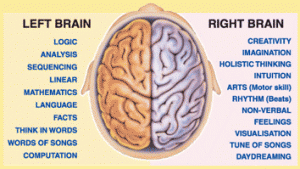Today I’m going to be discussing the 5 stages that can take you through the inception of a team to achieving it’s goals and finally to review and learning. As you go through these stages, you’ll see that any team has to consider both it’s Goal and Soul – the ‘hard’ and ‘soft’ side of a high performing team.
The High Performing Team Spiral guides team leaders, team sponsors or HR professionals charged with advising team leaders in building a high performing team. It follows a relatively descriptive and simple recipe approach to help you kick-off a team or diagnose team performance issues and find ideas for an intervention of an existing team. The spiral symbolizes a phased approach in which you can move to the next phase before completing the previous one. Similar the spiral is expansive in nature indicating the growth of a team
Purple Stage
The purple stage is the conception stage of a team. Here is where the team is born, formed and initial ice-breaking conversations are happening. At this stage this collective of individuals is just that, a group of individuals with at the most an intent to work and perform together
Goal: Pick the Right Team
Team members are chosen for what the experience, knowledge, skills and attitude they bring to the team. Differences in style are encouraged and team members are picked on the different team roles they can play. The size of the team is kept to a minimum and members are only selected if they can make the required commitment in time, energy and goodwill to succeed as a team.
Soul: Breaking the Ice
Team members get to know each, understand the importance of being open up about themselves, share why they want to be part of the team, what they want to get out of it and how they can contribute
Blue Stage
During the blue stage the team starts articulating what they want to achieve. Why they exist and why they want to spend time working together. They also start spending quality time together, go below the surface and address previous personal issues that potentially might damage the ability to establish a deep foundation of trust.
Goal: Co-create Aspirational Goal
Having picked a team with the right skills, experience, attitude and diversity it then co-creates a purpose that is meaningful and inspires each individual member to go over and beyond what they normally think is possible. The team knows that extraordinary achievement can only be achieved by setting extraordinary goals. They can connect both emotionally and rationally at a deeper level on why they exist and how they individually and collectively can contribute to this goal. Everybody is clear on what role he plays in the team and what he is expected to deliver.
Soul: Take a Personal Deep-Dive
To deliver outrageous results members of great teams need to trust one another on a deep emotional level. They are willing to open up and able to talk about their weaknesses, mistakes, fears, and behaviors. They know that they don’t have to be best friends but they understand the importance of complete openness and the need to invest in the relation in the pursue of their shared aspiration
Green Stage
The green stage is the final preparation stage. During this stage the team agrees what they need to do and how they want to work together to deliver in order to achieve its vision and goal.
Goal: Align Right Strategy
Knowing why they exist and where they want to go, the team reviews where they currently stand, what the context is within they have to deliver and never forget that the customer is central to whatever they do. They assess the opportunities, risk, barriers and challenges they can expect in the delivery of its aspirational goal. Having aligned themselves on where they stand they then start identify how they will get from their current status to the aspirational goal. They jointly develop a strategy that clarifies what needs to be done and who will do what.
Soul: Establish Ways of Working
Team members will initiate a debate on what they expect from each other, how they want to work together to deliver on their aspiration goal and agree rules of engagement that each member wants to follow. They identify and map their stakeholders and agree a way to influence them positively. They don’t only talk and know how they like to work together under ‘ideal circumstances’ but also agree how they deal with ‘breaches’ of their rules of engagement and how they will get their relations back on track in tough times.
Yellow Stage
The yellow stage is the execution stage. This is when the rubber hits the road and where all the plans and commitments are translated into actions. It will take some time before the team achieves a level of high performance and the team will most likely have to ‘fight’ its way through a number of implementation and team relation issues.
Goal: Deliver Results
Being clear on what needs to be done, the team then agrees on a way to make the right decisions fast. They make sure that all opinions and ideas are put forward and considered prior to making a collective decision but accept that minority views cant stop the progress of the team and accept the majority decisions. Team members agree to the utmost level of transparency and not hold back any information that could impact the delivery. They do not hesitate to hold one another accountable for following mutually agreed decisions and standards and don’t rely on the team leader to hold other team members accountable. They also agree on how they will communicate with each other and keep other stakeholders in the loop of progress and important decisions that impact stakeholders outside the team.
Soul: Care and Managing Conflict
Team members of high performing teams value differences and use these differences to the advantage of the team. They are not afraid to disagree, challenge and question each other around issues and decisions that matter as they want to get to the bottom of things, find the best solution and make great decisions that move the team forward. High performing team members trust that others will deliver on their commitment, look out for each other, extend a helping hand and have each other’s back. They strongly belief that team members shouldn’t take themselves too seriously and use every opportunity to have fun.
Orange Stage
The orange stage is the re-invention stage. It’s where teams learn, experiment, reflect, grow and persevere. It’s the stage where members can leave and join the team as the ‘ways of working’ are so established that new members will assimilate quickly. High performance is also recognized in this stage and individual growth becomes as important as team achievement.
Goal: Learn and Persevere
The team regularly takes time out to reflect on where they stand versus the original goals, review whether the context in which they operate has changed and adapt themselves to changing circumstances. They provide an opportunity for the team to change the strategy on the basis of past experience, success and failures. They accept that team members can leave and join the team and invest time and energy to ensure that new comers are taken on-board quickly. They push themselves with increasingly complex challenges and give each other the space to experiment and try a new way of doing things.
Soul: Celebrate and Grow
Team members take the time out not only to celebrate collective achievements but also to acknowledge individual contributions. They don’t envy each other as they know that each member only do what is best for the team and are not tempted by individual needs and personal agendas. They know that team success define their own success. They create space for individual and collective reflection and give one another constructive feedback, all in the spirit of helping each other collectively and individually grow. They invest time to ensure that the personal and collective energy levels are kept high
Articulating a team development process as above is relatively easy, although it took me some time to get it right!, implementing it is the real challenge Luckily I have had the opportunity to use this development spiral and its stage to help develop confused or in worse instances dysfunctional leadership team. The development spiral gives interventions a framework and helps them understand and self-assess where the biggest problem lies.
My personal experience is that the issues are often more related to the soul side rather than the goal side. And as the soul is much ‘softer’ people find them more difficult to grab and resolve. However, leaders that have understood the importance of building teams around both goal and soul have seen breakthrough transformations and performances of their team. Try it out, assess where your team stands and where it could use another ‘injection’ to ensure that both goal and soul are moved forward. I promise you the performance of the team will follow. Good luck!
(190)
Report Post





